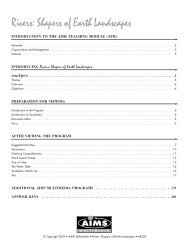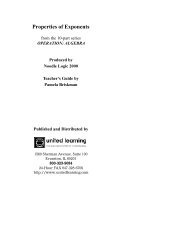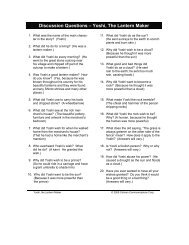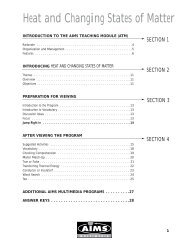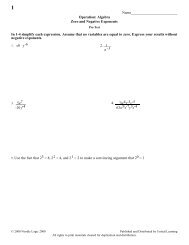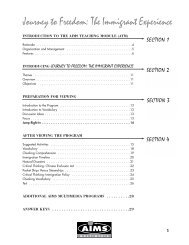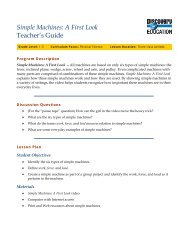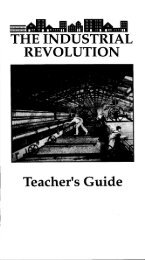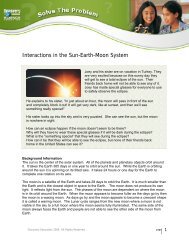Earthquakes: Historical Significance - Discovery Education
Earthquakes: Historical Significance - Discovery Education
Earthquakes: Historical Significance - Discovery Education
You also want an ePaper? Increase the reach of your titles
YUMPU automatically turns print PDFs into web optimized ePapers that Google loves.
Natural Events: Then & Now<strong>Earthquakes</strong>: <strong>Historical</strong> <strong>Significance</strong>Program1Program OverviewCalifornia’s history and geography help students to discover theimportant role earthquakes have played in creating California’slandscape, particularly its mountainous regions. True facts aboutearthquakes are introduced to dispel some of the myths andmisinformation that can cause needless concern.Students investigate earthquake impact and effect onCalifornia’s people. An historic and present day exploration ofearthquakes is also examined. Students learn how earthquakes canbring people together to help each other and to rebuild theircommunities. Safety and preparedness in the event of an earthquakeis also explored.Student OutcomesStudents will:• explore the characteristics of an earthquake• describe, or learn from others, their personal experiences withearthquakes• observe and experiment with the effects of a simulatedearthquake• compare an historic and present day earthquake• analyze and interpret primary sources to gather informationabout earthquake events• create a plan for earthquake preparednessMaterialsPre-Viewing Activity• Teacher Resources A– D, Activity: Natural Events Personified— A: Jake the Quake— B: Jud the Flood— C: Myer the Fire— D: Lind the WindProgram Viewing Activities• Various school suppliesTEAMS History/Social Science—Natural Events: Then and Now 1©2001-2002 Los Angeles County Office of <strong>Education</strong>
Natural Events: Then & Now<strong>Earthquakes</strong>: <strong>Historical</strong> <strong>Significance</strong>Program1• A fist-sized rock• Handout #1: Earthquake Country• Teacher Resource E: Tasty Quake (adapted from Tremor Troop-<strong>Earthquakes</strong>- National Science Teacher’s Association)• Silicone putty (Silly Putty)• Pan of prepared gelatin desert, one for each small group• Clear plastic wrap• Sugar cubes or dominoes• Spoon for serving dessert• Paper cups and spoons for individual portions• Handouts #2–7Primary Source- One Boy's Experience— Handout #2: Eyewitness Account– (Waking Up to aQuake)— Handout #3: Eyewitness Account– (Broken Pieces)— Handout #4: Eyewitness Account– (Confusion and Chaos)— Handout #5: Eyewitness Account– (Making Ends Meet)— Handout #6: Eyewitness Account– (It's Almost Over)— Handout #7: Eyewitness Account– (A New Beginning)• Handout #8: Earthquake ChecklistPost-Viewing Activities• Handout #12: Earthquake Safety Plan— Activity A: Emergency Kit— Activity B: The Escape Plan— Activity C: The Reunion PlanAdvance PreparationPre-Viewing Activity• Place each teacher resource A–D (Natural Events personified)in its own corner of the room. Make sure each visual is clearlydisplayed.TEAMS History/Social Science—Natural Events: Then and Now 2©2001-2002 Los Angeles County Office of <strong>Education</strong>
Natural Events: Then & Now<strong>Earthquakes</strong>: <strong>Historical</strong> <strong>Significance</strong>Program1Program Viewing Activities• Make a copy of Handout #1: Earthquake Country, one for eachstudent.• Prepare teacher resource activity: Tasty Quake, one set ofingredients and supplies for each small group.• Make a copy of Handout #2-7. One Handout assigned to eachgroup.— Handout #2: Eyewitness Account– (Waking Up to a Quake)— Handout #3: Eyewitness Account– (Broken Pieces)— Handout #4: Eyewitness Account– (Confusion and Chaos)— Handout #5: Eyewitness Account– (Making Ends Meet)— Handout #6: Eyewitness Account– (It's Almost Over)— Handout #7: Eyewitness Account– (A New Beginning)YOUR TIME #3: Tasty Quake, will be divided into shortsegments to guide students through the activity and discussionof ideas.• Make a copy of Handout #8–Earthquake Checklist, one foreach student.(Optional)Additional Primary Sources— Handout #9: Newspaper Headline— Handout #10: Newspaper Ad— Handout #11: PhotosTeachers who have access to the internet can locate theMuseum of the city of San Francisco for photos about theSan Francisco Earthquake of 1906.To locate the museum's web site, the address is:http://www.sfmuseum.org– click on 1906 earthquake photos– select photos of your choiceThese sources can be used to give your students additionalperspectives about the San Francisco Earthquake of 1906.TEAMS History/Social Science—Natural Events: Then and Now 3©2001-2002 Los Angeles County Office of <strong>Education</strong>
Natural Events: Then & Now<strong>Earthquakes</strong>: <strong>Historical</strong> <strong>Significance</strong>Program1Post-Viewing Activities• Make a copy of Handout #12: Earthquake Safety Plan, one foreach student.Pre-Viewing ActivityTitle: Natural Disaster PersonifiedActivityStudents brainstorm the characteristics of four natural disasters anddecide which natural disaster most reflects their personality.Procedure• Place teacher resources A-D in each corner of the room. Makesure each visual is clearly displayed.• Arrange class as a whole group.• Students discuss what they think and know about each naturaldisaster.• Students discuss various feelings.• Students move to the corner of the room of the natural disasterthat they think most reflects their personality.• Each group discusses why they are like the natural disaster.• Each group comes up with one sentence that tells why they arelike the natural disaster they have chosen.Example:We are like the earthquake because we shake, rattle, and roll.Program ViewingDLI Welcome and IntroductionDLIAPAPIntroduces Natural Disaster MuseumYOUR TIME“If I could talk...“– Students write about the effects of earthquakes fromthe perspective of an object or artifact from the"Natural Disaster Museum." DLI will give directions.YOUR TIMETEAMS History/Social Science—Natural Events: Then and Now 4©2001-2002 Los Angeles County Office of <strong>Education</strong>
Natural Events: Then & Now<strong>Earthquakes</strong>: <strong>Historical</strong> <strong>Significance</strong>Program1DLIAPEarthquake Explanation– What is an earthquake?YOUR TIME: Tasty Quake.– Students experiment with the effects of anearthquake.DLI <strong>Historical</strong> <strong>Significance</strong>: San Francisco Earthquake 1906APAPDLIDLIDLIAPEarthquake Mural– Students use an eyewitness account from theSan Francisco Earthquake of 1906 to read, discuss,and plan out a sketch that illustrates the effects of theearthquake.YOUR TIMEIntroduces internet sources for multiple perspectives onthe San Francisco Earthquake of 1906.Introduces a present day eyewitness account of anearthquake.Introduces a map that shows where earthquakes aremost likely to occur in the United States.Mappin' it out.Students color in earthquake risk areas on map.DLIAPDLIIntroduces Earthquake safety procedures.Safety Check-Off.Students use a checklist to check off items needed to beprepared in the event of an earthquake.ClosingKey DLI: Distance Learning Instructor AP: Audience ParticipationTEAMS History/Social Science—Natural Events: Then and Now 5©2001-2002 Los Angeles County Office of <strong>Education</strong>
Natural Events: Then & Now<strong>Earthquakes</strong>: <strong>Historical</strong> <strong>Significance</strong>Program1Post-Viewing ActivitiesTitle: Earthquake Safety PlanActivityStudents put together an emergency kit, and escape and reunionplan in the event of an earthquake or other natural disaster.Procedure• Activity A: Emergency Kit— Remind students about the importance of being preparedin the event of a natural disaster.— Discuss what needs to be included in an emergency kit.— Have students brainstorm list of supplies.— Students take list home as homework, underline suppliesthey already have and check off what they need.— Optional: Parents purchase needed supplies. Students putkit together. Students take a picture of completedemergency kit and include with homework.• Activity B: The Escape Plan— Students and parents decide where they will all cometogether as a group in the house.— Students and parents decide what doors and windows areemergency exits.— Students will draw and map out plan on paper.•Activity C: The Reunion Plan— Students and parents decide in the event they should getseparated, the steps they would take to be reunited again.— Decide what relative or friends would be contacted in theevent the family were separated.— Students include any other ideas that would reunite thefamily.— Student prioritize and write out plan in order, #1 being thefirst thing they would do.TEAMS History/Social Science—Natural Events: Then and Now 6©2001-2002 Los Angeles County Office of <strong>Education</strong>
Natural Events: Then & Now<strong>Earthquakes</strong>: <strong>Historical</strong> <strong>Significance</strong>Program1Title: Express YourselfActivityStudents use “I Am” Poem to express how they have felt or mightfeel during an earthquake or other natural event.Procedure• Arrange class as a whole group.• Begin a discussion about natural events by asking students toshare why natural events can be frightening to people.• Have students think about or imagine what they might feel orhave felt during a natural event such as an earthquake.• Students discuss various feelings.• Have students create an, “I Am” Poem to record their feelings.Handout #1: Express Yourself (from staff developmentprogram, pg. 6)• Students share in small groups their “I Am” Poem.• One person from each small group shares with the wholeclass.TEAMS History/Social Science—Natural Events: Then and Now 7©2001-2002 Los Angeles County Office of <strong>Education</strong>
Natural Events: Then & Now<strong>Earthquakes</strong>: <strong>Historical</strong> <strong>Significance</strong>Program1Handout #1: Earthquake CountryEarthquake Risk MapTEAMS History/Social Science—Natural Events: Then and Now 8©2001-2002 Los Angeles County Office of <strong>Education</strong>
Natural Events: Then & Now<strong>Earthquakes</strong>: <strong>Historical</strong> <strong>Significance</strong>Program1One Boy's ExperienceHandout #2: Eyewitness AccountWAKING UP TO A QUAKEA Member of the Roosevelt Boys’ Club writes of HisExperience During and After the Great Earthquake. BYLLOYD HEAD.It was between five and half-past five Wednesday morningthe temblor came: backwards, forwards, sidewards it shook,making things dance on the bureau as if they were alive,while the dishes in the pantry and the China closet rattledabout at a great rate.I guess no one had time to think what had happened, atleast I didn’t. I just held on to [the] side of the bed to keepfrom falling out and ducked my head in the pillow, for I wasso scared I couldn’t even yell. When the shaking hadsomewhat subsided I jumped up and ran into my mother’sroom where my father and mother and my small sister slept.My father didn’t seem scared very much but I guess he was,all the same, and so were all of us except the baby; she justsat up in bed and didn’t even cry, but I’ll bet she thought itwas kind of funny whenever we heard a rumble we all pileddown into the back yard as fast as we could.TEAMS History/Social Science—Natural Events: Then and Now 9©2001-2002 Los Angeles County Office of <strong>Education</strong>
Natural Events: Then & Now<strong>Earthquakes</strong>: <strong>Historical</strong> <strong>Significance</strong>Program1Handout #3: Eyewitness Account (cont.)One Boy's ExperienceBROKEN PIECESWhen we went upstairs again we looked in the pantry—what a scene! broken cups, saucers, plates; on the floor, inthe sink and everywhere. It was the same way in the parlorwhere some of our vases had broken. At first we thought thata number of things had been broken but we soon found outthat we had come off very lucky for the things that had brokenhad gone into so many pieces that it looked more than it reallywas. When we had cleaned up the broken crockery and brica-bracand eaten some sandwiches that my oldest sister hadbeen going to take to a picnic with her that day, we all feltbetter and went to the window to look out.TEAMS History/Social Science—Natural Events: Then and Now 10©2001-2002 Los Angeles County Office of <strong>Education</strong>
Natural Events: Then & Now<strong>Earthquakes</strong>: <strong>Historical</strong> <strong>Significance</strong>Program1Handout #4: Eyewitness Account (cont.)One Boy's ExperienceCONFUSION AND CHAOSPeople lined the sidewalks and everything was confusion.Looking up the street we could see where a large plate glasswindow had been broken in a store at the corner and when welooked away down town to see where the City Hall was youcould see right through it. A fire was blazing further downtown and rumors were spread around that the Cliff Househad fallen into the water and that certain cities along the coastwere under water.Nobody knew what to do and everybody seemed rattled.The fire was rapidly increasing and at intervals slightearthquakes would cause mall sized panics. People wouldrush to the middle of the street between the car tracks andstay there quite a while after the shock had passed away.TEAMS History/Social Science—Natural Events: Then and Now 11©2001-2002 Los Angeles County Office of <strong>Education</strong>
Natural Events: Then & Now<strong>Earthquakes</strong>: <strong>Historical</strong> <strong>Significance</strong>Program1Handout #5: Eyewitness Account (cont.)One Boy's ExperienceMAKING ENDS MEETWe had stayed in the house and ran down stairs at everyslight shock and we soon got tired of that so my mother andsister sewed some sacks together and my father and I made atent in the back yard and began a camp there; we made abrick fireplace in the yard by digging a hole in the dirt andplacing bricks around it, leaving a place for a draft and thenput a piece of tin over the bricks for a stove top. My motherthen went after some stuff to eat so that we wouldn’t be withoutsomething if we had to go up to the hills to get away from thefire. By the time it was gaining headway and cinders fromthe fire came floating down on us until there was a thin layerof them all over the yard.TEAMS History/Social Science—Natural Events: Then and Now 12©2001-2002 Los Angeles County Office of <strong>Education</strong>
Natural Events: Then & Now<strong>Earthquakes</strong>: <strong>Historical</strong> <strong>Significance</strong>Program1Handout #6: Eyewitness Account (cont.)One Boy's ExperienceIT'S ALMOST OVERThe sun shone blood-red through a thick haze of smoke andpeople began coming in a steady steam from the district nearthe fire. Some carried all they had save in little carts or wagonswhich had before been only playthings. Hatless, coatless,mothers and fathers, with children all packing somethingtrudged on in the direction of the hills. Night came and myfather and two sisters and I slept until morning in our tent.My mother stayed up all night watching the fire with my aunt,mother and grandmother who had come over to stay with usand had brought ample provisions for two or three days. Ourlittle brick stove now came in handy for we cooked all ourfood on it and if it had not been for the circumstances underwhich it occurred I believe we should all have enjoyed ourcamping out; but as it was it was anything but pleasant. Therewas no water and the noise of buildings being blown upcontinually startled us.TEAMS History/Social Science—Natural Events: Then and Now 13©2001-2002 Los Angeles County Office of <strong>Education</strong>
Natural Events: Then & Now<strong>Earthquakes</strong>: <strong>Historical</strong> <strong>Significance</strong>Program1Handout #7: Eyewitness Account (cont.)One Boy's ExperienceA NEW BEGINNINGMy father kept going down on his bicycle to find out where the firewas and on Thursday we packed two trunks that we had with asmuch of the necessary articles as we could ready to go to the hillsand Thursday evening when the fire was nearest us and at its worstwe lugged the trunks up to a little park near the hills [most likelyPrecita Park] and camped there over night. I rolled myself up in ablanket and went to sleep between my uncle and my father and wasas warm as could be. For the ladies we put up the sack tent we hadbrought from the back yard. When we awoke Friday morning thefire had practically died out and the Mission district was saved. Therewas still some fire quite a ways from us but people who had watchedthe fire all night said that when the firemen had got water enoughthey soon had it under control.We went home and for two or three days after the fire we had notmuch to do but get provisions, cook (now out in the street for therewere no more fires allowed in back yards), sleep and eat. The peopleseemed to take this all in good humor and when you walk aroundyou see the most comical names on some of the camps and on otherssuch names as Camp Thankful, Camp Grateful, etc.The above article was written some weeks ago, and the campsMaster Lloyd speaks of have now pretty well disappeared from thestreets. In the Mission district, where the Roosevelt Boys’ Club issituated there is little to be seen that is out of the ordinary away fromthe various relief camps in the parks.TEAMS History/Social Science—Natural Events: Then and Now 14©2001-2002 Los Angeles County Office of <strong>Education</strong>
Natural Events: Then & Now<strong>Earthquakes</strong>: <strong>Historical</strong> <strong>Significance</strong>Program1Handout #8: Earthquake ChecklistPut a checkmark (✓) next to all the things you need to do in order to beprepared for earthquake or other natural disasters.1. Emergency plan2. 3-5 day Home Pak— first aid kit handbook — glow stick— transistor radio with extra batteries — medicine— water — blankets— flashlight with extra batteries — can opener— wrench — tissues— canned dehydrated food3. Personal Needs— money— favorite toy— diapers— pet food and leash4. House— Beds are away from the windows.— Slippers and flashlight by every bed.— Computers, stereos, picture frames, mirrors, bookcases aresecured with wire hooks or brackets.— Child proof latches for kitchen cupboards.— Family practices drop and cover drills.— Parents know where main power for electricity, gas, andwater are located and how to turn them off.5. Other ideas?TEAMS History/Social Science—Natural Events: Then and Now 15©2001-2002 Los Angeles County Office of <strong>Education</strong>
Natural Events: Then & Now<strong>Earthquakes</strong>: <strong>Historical</strong> <strong>Significance</strong>Program1Handout #9: Newspaper HeadlineEARTHQUAKE & FIRESan Francisco in RuinsDeath and destruction have been thefate of San Francisco. Shaken by atrembler at 5:13 o’clock yesterdaymorning, the shock lasting 48 seconds,and scourged by flames that rageddiametrically in all directions, the cityis a mass of smouldering ruins. At sixo’clock last evening the flamesseemingly played with increased vigor,threatened to destroy such sections astheir fury had spared during the earlierportion of the day. Building their pathin a triangular circuit from the start inthe start in the early morning, theyjockeyed as the day waned, left thebusiness section, which they hadentirely devastated, and skipped in adozen directions to the residenceportions. As night fell they had madetheir way over into the North Beachsection and springing anew to theSouth they reached out along theshipping section down the bay shore,over the hills and across toward Thirdand Townsend Streets. Warehouses,wholesale houses and manufacturingconcerns fell in their path. Thiscompleted the destruction of the entiredistrict known as the “South of MarketStreet.” How far they are reaching tothe South across the channel cannotbe told as this part of the city is shutoff from San Francisco papers.After darkness, thousands of thehomeless were making their way withtheir blankets and scant provisions tothe Golden Gate Park and the beachto find shelter. Those in the homes onthe hills just North of the Hayes Valleywrecked section piled their belongingsin the streets and express wagons andautomobiles were hauling the thingsaway to the sparsely settled sections.Everybody in San Francisco isprepared to leave the city, for the beliefis firm that San Francisco will betotally destroyed. Downtowneverything is ruin.TEAMS History/Social Science—Natural Events: Then and Now 16©2001-2002 Los Angeles County Office of <strong>Education</strong>
Natural Events: Then & Now<strong>Earthquakes</strong>: <strong>Historical</strong> <strong>Significance</strong>Program1Handout #10: Newspaper Ad$100 REWARDJudge Ward McAllister LostThe undersigned will pay $100 gold reward forinformation leading to the recovery of Judge WardMcAllister (a paralytic), who was removed from McNuttHospital to Presidio Hospital and from there either tohospitals of the city, Vallejo, Mare Island, Napa, Susuin,etc., but has now disappeared. Description—Age 50,height 5:8, weight 140; brown beard, streaked with gray;brown hair, gray on right side of head; right arm whollyparalyzed; right leg partially; cannot articulate; can see,hear and understand. Any reliable detective wishing toundertake the case please call upon the undersigned.Country papers, especially Marin, Solano and ContraCosta papers please copy. Any information regardingabove please communicate withM. HALL McALLISTER2436 Jackson Street,San Francisco.San Francisco ChronicleApril 27, 1906TEAMS History/Social Science—Natural Events: Then and Now 17©2001-2002 Los Angeles County Office of <strong>Education</strong>
Natural Events: Then & Now<strong>Earthquakes</strong>: <strong>Historical</strong> <strong>Significance</strong>Program1Handout #11: PhotosPHOTO 1: Army refugee camp in Jefferson Square in the Western Addition. This remarkable photograph was taken at aboutGolden Gate and Octavia looking north to Turk Street. San Francisco’s Central Fire Alarm Station and Emergency CommandCenter today occupy the site in the middle of the photograph.TEAMS History/Social Science—Natural Events: Then and Now 18©2001-2002 Los Angeles County Office of <strong>Education</strong>
Natural Events: Then & Now<strong>Earthquakes</strong>: <strong>Historical</strong> <strong>Significance</strong>Program1PHOTO 2: Burned out Fairmont Hotel on Nob Hill looms over San Francisco. This is Market Street,somewhere between Taylor and Jones Streets. Construction of the six-story hotel was almost finishedwhen the earthquake struck. Although the exterior of the Fairmont appears sound, the interior wasbadly damaged by the fire, and was rebuilt.TEAMS History/Social Science—Natural Events: Then and Now 19©2001-2002 Los Angeles County Office of <strong>Education</strong>
Natural Events: Then & Now<strong>Earthquakes</strong>: <strong>Historical</strong> <strong>Significance</strong>Program1Handout #12: Earthquake Safety PlanActivity A: Emergency KitPrepare an earthquake safety kit. What do you think needs to be included?1. ________________________________ 6. _________________________________2. ________________________________ 7. _________________________________3. ________________________________ 8. _________________________________4. ________________________________ 9. _________________________________5. ________________________________ 10. _________________________________Other: __________________________________________________________________Activity B: Emergency Escape RouteMap out your emergency escape route in your home. Identify exits.Activity C: Emergency Reunion PlanWhat steps will you take to be reunited with your family in the event you are separatedfrom them during a natural disaster?1. ________________________________ 4. _________________________________2. ________________________________ 5. _________________________________3. ________________________________ 6. _________________________________TEAMS History/Social Science—Natural Events: Then and Now 20©2001-2002 Los Angeles County Office of <strong>Education</strong>
Natural Events: Then & Now<strong>Earthquakes</strong>: <strong>Historical</strong> <strong>Significance</strong>Program1Teacher Resource A: Jake the QuakeJake the QuakeTEAMS History/Social Science—Natural Events: Then and Now 21©2001-2002 Los Angeles County Office of <strong>Education</strong>
Natural Events: Then & Now<strong>Earthquakes</strong>: <strong>Historical</strong> <strong>Significance</strong>Program1Teacher Resource B: Jud the FloodJud the FloodTEAMS History/Social Science—Natural Events: Then and Now 22©2001-2002 Los Angeles County Office of <strong>Education</strong>
Natural Events: Then & Now<strong>Earthquakes</strong>: <strong>Historical</strong> <strong>Significance</strong>Program1Teacher Resource C: Myer the FireMyer the FireTEAMS History/Social Science—Natural Events: Then and Now 23©2001-2002 Los Angeles County Office of <strong>Education</strong>
Natural Events: Then & Now<strong>Earthquakes</strong>: <strong>Historical</strong> <strong>Significance</strong>Program1Teacher Resource D: Lind the WindLind the WindTEAMS History/Social Science—Natural Events: Then and Now 24©2001-2002 Los Angeles County Office of <strong>Education</strong>
Natural Events: Then & Now<strong>Earthquakes</strong>: <strong>Historical</strong> <strong>Significance</strong>Program1Teacher Resource E: Tasty QuakeDefining and Simulating anEarthquakeMaterialsFor each small group:• a fist-sized rock• silicone putty (widely available asSilly Putty)• one pan of prepared gelatin dessert(see recipe)• clear plastic wrap• sugar cubes or dominoes• spoon for serving dessert• paper cups and spoons for individualportionsProcedure1. Prepare gelatin dessert in advance andrefrigerate. These ingredients willmake one pan. Prepare one pan foreach small group (You may want toenlist parents to help.)2. Arrange class in small groups. DLIwill do the following demonstrationwith the students. Explain that underthe soil there are rock layers. Theselayers are under stress because ofactivity within the Earth. Explain thatwhen these rocks are under extremestress, they react more like a plasticmaterial such as silicone putty, thanlike the hard rock we see above theground. (Show rock and putty.)3. Demonstrate with Silly Putty. (Theputty will be difficult to break if it hasbeen warmed by too much handling,so work quickly.)— First, stretch the putty slowly toshow how rocks react to slowtwisting and pulling.— Next, shape it back into a ball andgive it a sharp tug with bothhands. The putty will snap intotwo pieces.— Explain that this reaction is similarto what happens during anearthquake.4. Explain that when rocks break in thissudden way energy is released in theform of waves. We can simulate thisrelease of energy by watching whathappens to a pan of gelatin.5. Gently tap the side of the pan ofgelatin, while holding the pan firmlywith the other hand. Students shouldbe able to see the waves travelingthrough the gelatin. Compare thegelatin to the ground. The tap of yourhand to the rock breaking, and thewaves in the gelatin to earthquakewaves.6. Ask the students to predict what willhappen when you tap the pan withmore force. Tap the pan harder. Is theirprediction confirmed? Repeat thesetwo steps several times, and be surethat all the students have a chance tosee the waves.TEAMS History/Social Science—Natural Events: Then and Now 25©2001-2002 Los Angeles County Office of <strong>Education</strong>
Natural Events: Then & Now<strong>Earthquakes</strong>: <strong>Historical</strong> <strong>Significance</strong>Program17. Cover the top of the gelatin withplastic wrap so it will be clean enoughto eat later. Be sure the wrap touchesthe gelatin. Ask the students whatthey think happens to buildingsduring an earthquake. Then let themdistribute sugar cubes or domino“buildings” over the plastic wrap.8. Repeat steps 5 and 6 above. Replaceany buildings that are knocked overduring the first trial. Allow students toconstruct different kinds of buildingsand predict their resistance to the“earthquake,” then test theirpredictions.9. Later, the plastic wrap can be removedand the gelatin served to the students.While they are eating, point out theirillustrations from Activity One, anddiscuss. Do any of them come close towhat scientists believe aboutearthquakes?Source: <strong>Earthquakes</strong>-NSTA/FEMA—Gelatin Dessert—2 170-g (6-oz) boxes of red or purple gelatin dessert2 one-serving envelopes of unflavored gelatin4 cups boiling water4 cups cold water1 23 x 30 cm (9 x 12 in.) metal baking panEmpty the gelatin dessert and the unflavored gelatin into the baking pan.Add the boiling water and stir until all the powder is dissolved, then addthe cold water and stir to mix. Chill on refrigerator shelf at least threehours or until set.Note: This recipe has been carefully tested. To transmit waves that can beseen easily, the pan must be metal, and it must be full nearly to the topwith the gelatin mixture.TEAMS History/Social Science—Natural Events: Then and Now 26©2001-2002 Los Angeles County Office of <strong>Education</strong>






